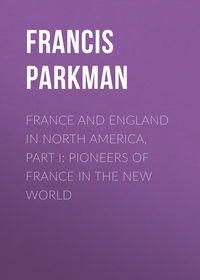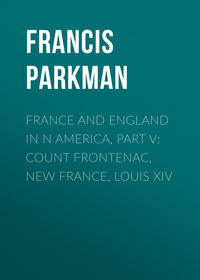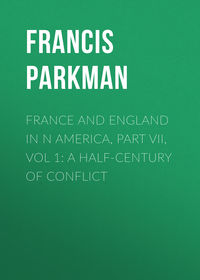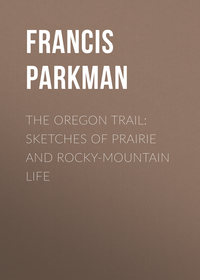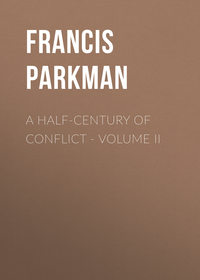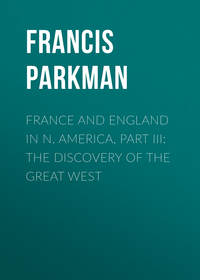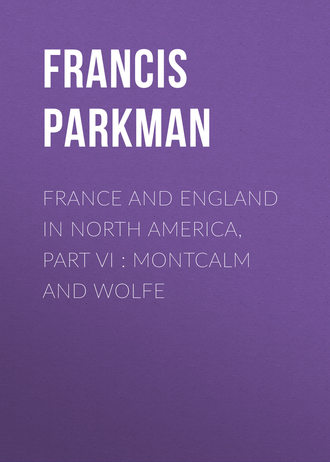 полная версия
полная версияFrance and England in North America, Part VI : Montcalm and Wolfe
Appendix K
CHAPTER XXIX. SAINTE-FOYStrength of the French and English at the Battle of Ste.-FoyIn the Public Record Office (America and West Indies, XCIX.) are preserved the tabular returns of the garrison of Quebec for 1759, 1760, sent by Murray to the War Office. They show the exact condition of each regiment, in all ranks, for every month of the autumn, winter, and spring. The return made out on the 24th of April, four days before the battle, shows that the total number of rank and file, exclusive of non-commissioned officers and drummers, was 6,808, of whom 2,612 were fit for duty in Quebec, and 654 at other places in Canada; that is, at Ste.-Foy, Old Lorette, and the other outposts. This gives a total of 3,266 rank and file fit for duty at or near Quebec; besides which there were between one hundred and two hundred artillerymen, and a company of rangers. This was Murray's whole available force at the time. Of the rest of the 6,808 who appear in the return, 2,299 were invalids at Quebec, and 669 in New York; 538 were on service in Halifax and New York, and 36 were absent on furlough. These figures nearly answer to the condensed statement of Fraser, and confirm the various English statements of the numbers that took part in the battle; namely, 3,140 (Knox), 3,000 (John Johnson), 3,111, and elsewhere, in round numbers, 3,000 (Murray). Lévis, with natural exaggeration, says 4,000. Three or four hundred were left in Quebec to guard the walls when the rest marched out.
I have been thus particular because a Canadian writer, Garneau, says: "Murray sortit de la ville le 28 au matin à la tête de toute la garnison, dont les seules troupes de la ligne comptaient encore 7,714 combattants, non compris les officiers." To prove this, he cites the pay-roll of the garrison; which, in fact, corresponds to the returns of the same date, if non-commissioned officers, drummers, and artillerymen are counted with the rank and file. But Garneau falls into a double error. He assumes, first, that there were no men on the sick list; and secondly, that there were none absent from Quebec; when in reality, as the returns show, considerably more than half were in one or the other of these categories. The pay-rolls were made out at the headquarters of each corps, and always included the entire number of men enlisted in it, whether sick or well, present or absent. On the same fallacious premises Garneau affirms that Wolfe, at the battle on the Plains of Abraham, had eight thousand soldiers, or a little less than double his actual force.
Having stated, as above, that Murray marched out of Quebec with at least 7,714 effective troops, Garneau, not very consistently, goes on to say that he advanced against Lévis with six thousand or seven thousand men; and he adds that the two armies were about equal, because Lévis had left some detachments behind to guard his boats and artillery. The number of the French, after they had all reached the field, was, in truth, about seven thousand; at the beginning of the fight it seems not to have exceeded five thousand. The Relation de la seconde Bataille de Québec says: "Notre petite armée consistoit au moment de l'action en 3,000 hommes de troupes reglées et 2,000 Canadiens ou sauvages." A large number of Canadians came up from Sillery while the affair went on; and as the whole French army, except the detachments mentioned by Garneau, had passed the night at no greater distance from the field than Ste.-Foy and Sillery, the last man must have reached it before the firing was half over.
Francis Parkman
France and England in North America1. Pioneers of France in the New World (1865)
Revised (1885)
2. The Jesuits in North America in the seventeenth century (1867)
3. The Discovery of the West (1869)
La Salle and the Discovery of the Great West (1879)
4. The Old Régime in Canada (1874)
Revised (1894)
5. Count Frontenac and New France under Louis XIV. (1877)
6. A Half Century of Conflict (1892)
Volume 1
Volume 2
7. Montcalm and Wolfe (1884)
The year that each book was published is printed and enclosed by parenthesis after the title of each volume. In three cases, there are two listings for a line item. For those parts, Parkman issued a volume with major revisions subsequent to the initial release of the book.
The revised version of Pioneers of France (Part One) contains new descriptions of Florida and some changes to the section on Samuel Champlain. Parkman revised Discovery of the West (Part Three) after obtaining access to Margry's collection. The revised version of The Old Régime (Part Four) includes three new chapters regarding La Tour and D'Aunay.
Volume 3 was not only revised, but the title was altered. Parkman first released Volume 3 as The Discovery of the West. His updated version of Volume 3 was entitled La Salle and the Discovery of the Great West.
Other Principal Works• The Oregon Trail (1849)
• The Conspiracy of Pontiac (1851)
1
Censuses of Canada, iv. 61. Rameau (La France aux Colonies, II. 81) estimates the Canadian population, in 1755, at sixty-six thousand, besides voyageurs, Indian traders, etc. Vaudreuil, in 1760, places it at seventy thousand.
2
La Galissonière, Mémoire sur les Colonies de la France dans l'Amérique septentrionale.
3
Gordon, Journal, 1766, appended to Pownall, Topographical Description. In the Dépôt des Cartes de la Marine at Paris, C. 4,040, are two curious maps of the Illinois colony, made a little after the middle of the century. In 1753 the Marquis Duquesne denounced the colonists as debauched and lazy.
4
"De toutes les nations domiciliées dans les postes des pays d'en haut, il n'y a que les hurons du détroit qui aient embrassé la Réligion chretienne." Mémoirs du Roy pour servir d'instruction au Sr. Marquis de Lajonquière.
5
Dinwiddie to Hamilton, 21 May, 1753. Hamilton to Dinwiddie,—May, 1753.
6
Céloron, Journal. Compare the letter as translated in N. Y. Col. Docs., VI. 532; also Colonial Records of Pa., V. 425.
7
There was another Chiningué, the Shenango of the English, on the Alleghany.
8
O. H. Marshall, in Magazine of American History, March, 1878.
9
For papers relating to it, see Trans. Amer. Antiq. Soc., II.
10
For a fac-simile of the inscription on this plate, see Olden Time, I. 288. Céloron calls the Kenawha, Chinodahichetha. The inscriptions as given in his Journal correspond with those on the plates discovered.
11
Céloron, Journal. Compare A Message from the Twightwees (Miamis) in Colonial Records of Pa., V. 437, where they say that they refused the gifts.
12
Journal de la Campagne que moy Céloron, Chevalier de l'Ordre Royal et Militaire de St. Louis, Capitaine Commandant un détachement envoyé dans la Belle Rivière par les ordres de M. le Marquis de La Galissonière, etc.
Relation d'un voyage dans la Belle Rivière sous les ordres de M. de Céloron, par le Père Bonnecamp, en 1749.
13
Instructions to Gist, in appendix to Pownall, Topographical Description of North America.
14
Mr. Croghan's Transactions with the Indians, in N. Y. Col. Docs., VII. 267; Croghan to Hamilton, 16 Dec. 1750.
15
This is stated by Count Zinzendorf, who visited her among the Senecas. Compare Frontenac and New France under Louis XIV., p. 376. In a plan of the "Route of the Western Army," made in 1779, and of which a tracing is before me, the village where she lived is still called "French Catharine's Town."
16
Journal of Zinzendorf, quoted in Schweinitz, Life of David Zeisberger, 112, note.
17
Compare Message of Miamis and Hurons to the Governor of Pennsylvania in N. Y. Col. Docs., VI. 594; and Report of Croghan in Colonial Records of Pa., V. 522, 523.
18
Journal of Christopher Gist, in appendix to Pownall, Topographical Description. Mr. Croghan's Transactions with the Indians in N. Y. Col. Docs., VII. 267.
19
Joncaire made anti-English speeches to the Ohio Indians under the eyes of the English themselves, who did not molest him. Journal of George Croghan, 1751, in Olden Time, I. 136.
20
Mr. Croghan's Transactions with the Indians, N. Y. Col. Docs., VII. 267.
21
Colonial Records of Pa., V. 515, 529, 547. At a council at Logstown (1751), the Indians said to Croghan: "The French want to cheat us out of our country; but we will stop them, and, Brothers the English, you must help us. We expect that you will build a strong house on the River Ohio, that in case of war we may have a place to secure our wives and children, likewise our brothers that come to trade with us." Report of Treaty at Logstown, Ibid., V. 538.
22
Dinwiddie to the Lords of Trade, 6 Oct. 1752.
23
Journals of New York Assembly, II. 283, 284. Colonial Records of Pa., V. 466.
24
Clinton to Hamilton, 18 Dec. 1750. Clinton to Lords of Trade, 13 June, 1751; Ibid., 17 July, 1751.
25
Clinton to Bedford, 30 July, 1750.
26
Johnson to Clinton, 28 April, 1749.
27
The estimate of a French official report, 1736, and of Sir William Johnson, 1763.
28
La Jonquière au Ministre, 27 Fév. 1750. Ibid., 29 Oct. 1751. Ordres du Roy et Dépêches des Ministres, 1751. Notice biographique de la Jonquière. La Jonquière, governor of Canada, at last broke up their contraband trade, and ordered Tournois to Quebec.
29
I once saw a contemporary portrait of him at the mission of Two Mountains, where he had been stationed.
30
Rouillé à la Jonquière, 1749. The Intendant Bigot gave him money and provisions. N. Y. Col. Docs., X. 204.
31
Journal of Conrad Weiser, 1750.
32
Lalande, Notice de l'Abbé Piquet, in Lettres Édifiantes. See also Tassé in Revue Canadienne, 1870, p. 9.
33
Piquet à la Jonquière et Bigot, 8 Fév. 1752. SeeAppendix A. In spite of Piquet's self-laudation, and in spite also of the detraction of the author of the Mémoires sur le Canada, 1749-1760, there can be no doubt of his practical capacity and his fertility of resource. Duquesne, when governor of the colony, highly praises "ses talents et son activité pour le service de Sa Majesté."
34
Appendix A.
35
On Toronto, La Jonquière et Bigot au Ministre, 1749. La Jonquière au Ministre, 30 Août, 1750. N. Y. Col. Docs., X. 201, 246.
36
La Jonquière au Ministre, 23 Fév. 1750. Ibid., 6 Oct. 1751. Compare Colonial Records of Pa., V. 508.
37
Lieutenant Lindesay to Johnson, July, 1751.
38
Clinton to Lords of Trade, 30 July, 1750.
39
Journal of Conrad Weiser, 1750.
40
Compare Doc. Hist. N. Y., I. 463.
41
Journal qui peut servir de Mémoire et de Relation du Voyage que j'ay fait sur le Lac Ontario pour attirer au nouvel Établissement de La Présentation les Sauvages Iroquois des Cinq Nations, 1751. The last passage given above is condensed in the rendering, as the original is extremely involved and ungrammatical.
42
La Jonquière au Ministre, 24 Août, 1750.
43
Relation du Voiage de la Belle Rivière, 1749.
44
A plan of Detroit is before me, made about this time by the engineer Lery.
45
Le Ministre à la Jonquière et Bigot, 14 Mai, 1749. Le Ministre à Céloron, 23 Mai, 1749.
46
Ordonnance du 2 Jan. 1750. La Jonquière et Bigot au Ministre, 1750. Forty-six persons of all ages and both sexes had been induced by La Galissonière to go the year before. Lettres communes de la Jonquière et Bigot, 1749. The total fixed population of Detroit and its neighborhood in 1750 is stated at four hundred and eighty-three souls. In the following two years, a considerable number of young men came of their own accord, and Céloron wrote to Montreal to ask for girls to marry them.
47
Le Ministre à la Galissonière, 14 Mai, 1749.
48
Mémoires sur le Canada, 1749-1760. The charges made here and elsewhere are denied, somewhat faintly, by a descendant of La Jonquière in his elaborate Notice biographique of his ancestor.
49
Le Ministre à La Jonquière, Mai, 1749. The instructions given to La Jonquière before leaving France also urge the necessity of destroying Oswego.
50
Ordres du Roy et Dépêches des Ministres; à MM. de la Jonquière et Bigot, 15 Avril, 1750. SeeAppendix A. for original.
51
Ordres du Roy et Dépêches des Ministres, 1750.
52
Chalmers, Collection of Treaties, I. 382.
53
La Jonquière à Clinton, 10 Août, 1751.
54
Deposition of Morris Turner and Ralph Kilgore, in Colonial Records of Pa., V. 482. The deponents had been prisoners at Detroit.
55
Précis des Faits, avec leurs Pièces justificatives, 100.
56
Ordres du Roy et Dépêches des Ministres, 1750.
57
Ibid., 6 Juin, 1751.
58
La Jonquière au Ministre, 19 Oct. 1751.
59
Ordres du Roy et Dépêches des Ministres, 1751.
60
He died on the sixth of March, 1752 (Bigot au Ministre, 6 Mai); not on the seventeenth of May, as stated in the Mémoires sur le Canada, 1749-1760.
61
Dépêches de Longueuil; Lettres de Raymond; Benoit de Saint-Clerc à la Jonquière, Oct. 1751.
62
Longueuil au Ministre, 21 Avril, 1752.
63
Le Ministre à la Jonquière, 1752. Le Ministre à Duquesne, 9 Juillet, 1752.
64
La Jonquière à Céloron, 1 Oct. 1751.
65
On the attack of Pickawillany, Longueuil au Ministre, 18 Août, 1752; Duquesne au Ministre, 25 Oct. 1752; Colonial Records of Pa., V. 599; Journal of William Trent, 1752. Trent was on the spot a few days after the affair.
66
Ordres du Roy et Dépêches des Ministres, 1753.
67
Duquesne au Ministre, 29 Sept. 1754.
68
Pouchot, Mémoire sur la dernière Guerre de l'Amérique septentrionale (ed. 1781), I. 8.
69
Duquesne au Ministre, 27 Oct. 1753.
70
Johnson to Clinton, 20 April, 1753, in N. Y. Col. Docs., VI. 778.
71
Holland to Clinton, 15 May, 1753, in N. Y. Col. Docs., VI. 780.
72
See the numerous papers in Selections from the Public Documents of the Province of Nova Scotia (Halifax, 1869), pp. 1-165; a Government publication of great value.
73
The oath was literatim as follows: "Je Promets et Jure Sincerement en Foi de Chrétien que Je serai entierement Fidele, et Obeierai Vraiment Sa Majesté Le Roy George Second, qui (sic) Je reconnoi pour Le Souvrain Seigneur de l'Accadie ou Nouvelle Ecosse. Ainsi Dieu me Soit en Aide."
74
Description de l'Acadie, avec le Nom des Paroisses et le Nombre des Habitants, 1748. Mémoire à présenter à la Cour sur la Necessité de fixer les Limites de l'Acadie, par l'Abbé de l'Isle-Dieu, 1753 (1754?). Compare the estimates in Censuses of Canada (Ottawa, 1876.)
75
La Jonquière à l'Évêque de Québec, 14 Juin, 1750. Mémoire du Roy pour servir d'Instruction au Comte de Raymond, commandant pour Sa Majesté à l'Isle Royale [Cape Breton], 24 Avril, 1751.
76
SeeAppendix B.
77
Public Documents of Nova Scotia, 173.
78
See Ibid., 174, where the answer is printed.
79
Cornwallis to the Board of Trade, 11 Sept. 1749.
80
La Jonquière au Ministre, 9 Oct. 1749. SeeAppendix B.
81
Resumé des Lettres lues au Travail du Roy, Mai, 1750.
82
In 1750 nine captured deserters from Phillips's regiment declared on their trial that the French had aided them and supplied them all with money. Public Documents of Nova Scotia, 193.
83
Le Ministre à Desherbiers, 23 Mai, 1750; Ibid., 31 Mai, 1750.
84
Mémoire du Roy pour servir d'Instruction au Comte de Raymond, 24 Avril, 1751.
85
Lettre commune de Desherbiers et Bigot au Ministre, 15 Août, 1749.
86
Longueuil au Ministre, 26 Avril, 1752.
87
Bigot au Ministre, 1749.
88
Dépêches de la Jonquière, 1 Mai, 1751. SeeAppendix B.
89
Prévost au Ministre, 12 Mars, 1753; Ibid., 17 July, 1753. Prévost was ordonnateur, or intendant, at Louisbourg. The treaty will be found in full in Public Documents of Nova Scotia, 683.
90
Prévost au Ministre, 16 Août, 1753.
91
Ibid., 22 Juillet, 1750.
92
Le Ministre au Comte de Raymond, 21 Juillet, 1752. It is curious to compare these secret instructions, given by the Minister to the colonial officials, with a letter which the same Minister, Rouillé, wrote ostensibly to La Jonquière, but which was really meant for the eye of the British Minister at Versailles, Lord Albemarle, to whom it was shown in proof of French good faith. It was afterwards printed, along with other papers, in a small volume called Précis des Faits, avec leurs Pièces justificatives which was sent by the French Government to all the courts of Europe to show that the English alone were answerable for the war. The letter, it is needless to say, breathes the highest sentiments of international honor.
93
L'Isle-Dieu, Mémoire sur l'État actuel des Missions, 1753 (1754?).
94
Longueuil au Ministre, 27 Avril, 1752.
95
Cornwallis to the Bishop of Quebec, 1 Dec. 1749.
96
Daudin, prêtre, à Prévost, 23 Oct. 1753. Prévost au Ministre, 24 Nov. 1753.
97
Mémoire à présenter à la Cour, 1753.
98
Roma au Ministre, 11 Mars, 1750.
99
Mémoires sur le Canada, 1749-1760.
100
Bonaventure à Desherbiers, 26 Juin, 1751.
101
Prévost au Ministre, 25 Nov. 1750.
102
Bonaventure, ut supra.
103
Girard à (Bonaventure?), 27 Oct. 1753.
104
The above passages are from two address of Cornwallis, read to the Acadian deputies in April and May, 1750. The combined extracts here given convey the spirit of the whole. See Public Documents of Nova Scotia, 185-190.
105
Public Documents of Nova Scotia, 197.
106
L'Évêque de Québec à Le Loutre; translation in Public Documents of Nova Scotia, 240.
107
Mémoires sur le Canada, 1749-1760.
108
On Le Loutre, compare Public Documents of Nova Scotia, 178-180, note, with authorities there cited; N. Y. Col. Docs., X. 11; Mémoires sur le Canada, 1749-1760 (Quebec, 1838).
109
La Jonquière himself admits that he thought so. "Cette partie là étant, à ce que je crois, dépendante de l'Acadie." La Jonquière au Ministre, 3 Oct. 1750.
110
It has been erroneously stated that Beaubassin was burned by its own inhabitants. "Laloutre, ayant vu que les Acadiens ne paroissoient pas fort pressés d'abandonner leurs biens, avoit lui-même mis le feu à l'Église, et l'avoit fait mettre aux maisons des habitants par quelques-uns de ceux qu'il avoit gagnés," etc. Mémoires sur le Canada, 1749-1760. "Les sauvages y mirent le feu." Précis des Faits, 85. "Les sauvages mirent le feu aux maisons." Prévost au Ministre, 22 Juillet, 1750.
111
La Vallière, Journal de ce qui s'est passé à Chenitou [Chignecto] et autres parties des Frontières de l'Acadie, 1750-1751. La Vallière was an officer on the spot to the footnote written.
112
Prévost au Ministre, 27 Sept. 1750.
113
"Les sauvages et Accadiens mirent le feu dans toutes les maisons et granges, pleines de bled et de fourrages, ce qui a causé une grande disette." La Vallière, ut supra.




